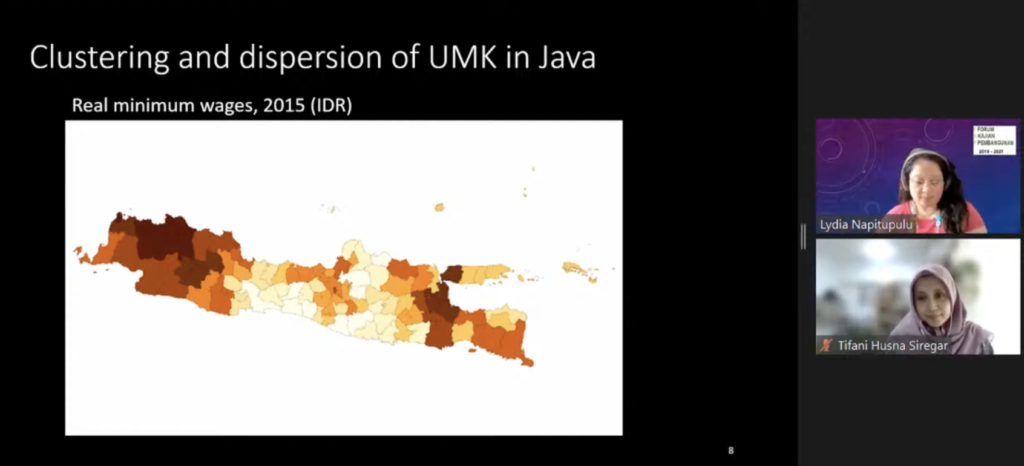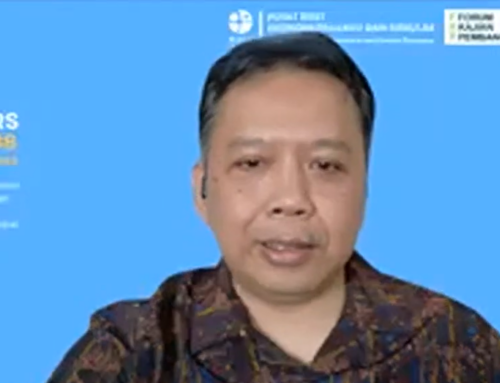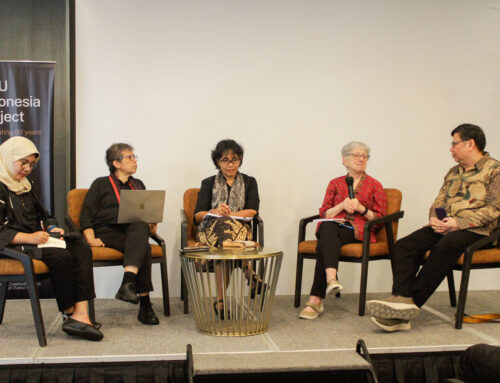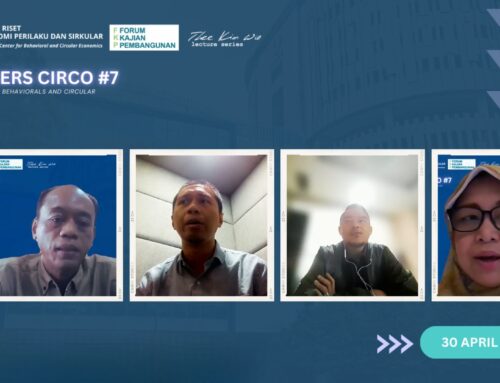FKP hosted by ANU Indonesia Project with Tifani Husna Siregar (Waseda University). Thursday, 26 August 2021.
Update: this paper has been published in the Bulletin of Indonesian Economic Studies volume 58 (2), 2022
KEY POINTS:
- There are still very few studies in the world which account for spatial correlation among labor markets, and none for Indonesia. This study reassesses the impacts of minimum wages on formal and informal sector employment, unemployment and labour participation by employing the Spatial Durbin Model for the estimation and letting labour markets to be spatially correlated across districts.
- The main findings suggest that minimum wage hikes mainly affect the local labour market where the minimum wage increase occurs. The spillover impacts of a minimum wage increase on neighbouring districts are negligible, except for its impact on labour participation. The results of this study highlight the need to account for spatial dependence when modelling formal sector employment, unemployment and labour participation, as we found those variables to be geographically correlated, at least across districts in Java.
SUMMARY
- Economists have yet to reach a consensus on the employment impacts of minimum wages. Contrary to the earlier studies, recent studies show that there is no significant impact of minimum wages on employment. The different results by those studies are due to different methods that are used (national level time series/panel data, local contiguous areas with different minimum wage levels) and different underlying assumptions (coverage of the minimum wage, difference in sample selection, spatial independence among labour markets). In Indonesia, minimum wage studies also show various results: many of them focus on the formal sector and find negative effects, while others have incorporated the informal (self-employed) sector, and the results varied. Further, there are still very few studies which account for spatial correlation among labor markets and none yet for Indonesia. Tifani Husna Siregar, PhD candidate at Waseda University, discusses her research about the effects of minimum wages on employment, unemployment, and labour participation in Java, Indonesia. Her research focuses on investigating the spatial correlation of the labor market and the spillover effects of the change of minimum wage from one district to the other.
- The study uses both spatial and non-spatial models to examine the effect of the change in minimum wage. From the non-spatial model, this study found that a 10% increase in minimum wages is expected to lower formal sector employment by 2.3%, while the effect on informal sector employment is non-significant. Minimum wage increase is also expected to increase unemployment and lower labor participation. In addition, the negative effect of the increase of minimum wage disproportionately affects female workers more than male workers.
- From the spatial model (main results), the study found that there are spillover effects from neighboring districts’ formal sector employment, unemployment, and labor force participation (females) to the district of reference. As for the marginal effect of minimum wages, the impact of minimum wages on employment is local. Unlike the result from the non-spatial mode, the effect of change in minimum wage on formal sector employment is non-significant. This might suggest that the labor market in Indonesia is relatively less elastic than what was concluded by previous studies that did not account for spatial correlation. Furthermore, in the informal sector, there is a positive total effect of minimum wage rise, where a 10% increase in minimum wages is associated with a 1.6% increase in informal employment. In terms of unemployment, overall, the rise in minimum wage increases unemployment. However, this was not due to lower employment, but rather to higher labor participation. This result also cannot determine whether the increase is caused by migrants from neighbouring districts or the people who are already residents of the district. Lastly, an increase in minimum wages is expected to raise labor force participation in the district of reference and lower it in the neighbouring districts.
- In conclusion, the main findings suggest that minimum wage hikes mainly affect the local labour market where the minimum wage increase occurs. The spillover impacts of a minimum wage increase on neighbouring districts are negligible, except for its impact on labour participation. The results of this study highlight the need to account for spatial dependence when modelling formal sector employment, unemployment and labour participation, as we found those variables to be geographically correlated, at least across districts in Java. Policies designed to affect a single labour market will likely have spillover effects on neighbouring markets. In the case of minimum wages or similar programs which increase a worker’s expected income, more migrants are likely to be attracted to the district where the policy will be implemented. Future research on labour market policies should explicitly examine the mobility incentives the policies create.





